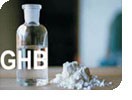|
|
 |
| GHB |
 Gamma-hydroxybutyrate (GHB), is a compound that was initially used by body builders to stimulate muscle growth. In recent years it has become popular as a recreational drug among club kids and partygoers. GHB is a synthetically produced central nervous system depressant. Gamma-hydroxybutyrate (GHB), is a compound that was initially used by body builders to stimulate muscle growth. In recent years it has become popular as a recreational drug among club kids and partygoers. GHB is a synthetically produced central nervous system depressant.

This “designer” drug is often used in combination with other drugs, particularly ecstasy. GHB is synthesized from a chemical used to clean electrical circuit boards. GHB is often manufactured in homes with recipes and kits found and purchased on the Internet. |
 |
What does it look like?
In liquid form, GHB is colorless and odorless and has a salty or soapy taste; however it is often diluted in liquids and virtually undetectable. GHB is also sold in powder or capsule form. |
 |
How is it used?
In powder form, measuring a dose is fairly straightforward. On the street, it is usually sold as a liquid by the dose. In liquid form, GHB comes in a wide variety of concentrations with a single dose ranging from a few drops to a full glass. In some cities, GHB is put into water guns, and users buy it by the squirt. In other instances, candy, such as a lollipop, is dipped in GHB and sold. |
 |
Who uses GHB?
The majority of GHB users are young adults. Many of these users do not realize that GHB affects each person differently or that differences in the purity and strength of the dose can mean the difference between life and death. Misinformation on the Internet may also contribute to the problem. GHB is described on many Web sites as a relatively benign drug. Addiction and the possibilities of overdose and death generally are downplayed. The use of GHB as a date-rape drug is often dismissed as media hype. |
 |
| GHB use is most common among white, middle-class males between ages 13 and 30. However, there are geographic and population variances in GHB use. |
 |
| Despite the belief of some users that GHB is a safe body-building or sleep aid, or a party drug that poses no risk for addiction or overdose, the effects of GHB can betragic. |
 |
| The only legitimate use of GHB in the U.S. is for the treatment of cataplexy, a symptom of the sleep disorder narcolepsy in which muscles lose strength. The U.S. Food & Drug Administration approved GHB, under the brand name Xyrem, in July 2002, but mandated some of the most severe restrictions ever imposed on amedicine. |
 |
Short Term Effects
At lower doses, GHB can relieve anxiety and produce relaxation. As the dose increases, the sedative effects may result in sleep and eventual coma or death. GHB is often produced in clandestine laboratories; therefore, the purity and strength of doses vary. This situation makes it difficult for emergency personnel to obtain useful information on the amount of GHB that a person took. |
 |
| Adverse effects of GHB include vomiting, seizure-like activity, loss of consciousness, respiratory arrest, coma, and death. |
 |
Why is GHB so dangerous?
GHB, usually in combination with alcohol, was linked to more than 60 deaths from January 1992 to May 2001. Almost 60% of these deaths were people between ages 20 and 29. However, the number of GHB-related deaths may be underestimated because GHB does not remain in the body long and is usually not tested for at autopsy. |
 |
| The effects of GHB vary each time a person takes it, and it affects each person differently. A small increase in dose can increase the drug’s sedative effects to a lethal level. High doses of GHB may overwhelm the body’s ability to eliminate the drug; therefore, the effect. |
 |
Dependence and Withdrawal
Severe GHB dependence was found to follow daily use of varying amounts of GHB over a period ranging from 2 months to 3 years according to the findings in a retrospective study of eight patients with prolonged withdrawal symptoms after discontinuing chronic use of GHB. |
 |
Researchers found that withdrawal symptoms started between 1 and 6 hours after the last dose and lasted between 5 and 15 days. One person died from cardiac complications on the 13th day. Reported withdrawal symptoms included:- psychosis and severe agitation requiring self-protection procedures and sedation
- mild tachycardia (increased heart rate) and hypertension
- neurologic effects, including prolonged delirium
- hallucinations
- diaphoresis (profuse sweating), nausea, and vomiting
|
 |
What are the symptoms of a GHB overdose?
Symptoms of GHB overdose include nausea, bradycardia (slow heart rate), and a decreased level of consciousness. |
 |



